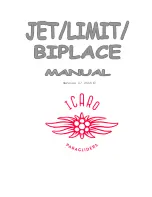
P92 Echo Super
Maintenance Manual
!
The rudder consists of an aluminum alloy torque tube (3), formed sheet metal ribs (4) and sheet-metal panel cover (5) held
in place by rivets.
The rudder rotates about its torque tube via two, specially designed hinges (parts 6 and 7). The top hinge pin rotates about a
bushing embedded in the topmost ordinate of the vertical stabilizer. The bottom hinge pin rotates about a bushing (8)
embedded within a support flange attached to vertical stabilizer aft spar. A bellcrank (9) secured to the rudder's lower hing e
converts the rudder pedals cable commands.
!
Figure 4-8 Vertical stabilizer, rudder and supports
!
Rudder mass balancing (10) is via a counterweight attached to a prong coupled, in turn, to the upper end of the rudder
torque tube. Weight and prong move within stabilizer tip and within specially designed fairings (one is removable) for
overhang.
To remove rudder, after removing tail fairing, disconnect cables from bellcrank, unfasten lower support flange from
stabilizer and uncouple rudder with downward motion.
Control system layout (fig. 4-9) is steel cable driven and circuit terminates on nose wheel steering lever.
Rudder pedals (1) are attached to two pushrods (3) that terminate the control circuit (2) for the rudder and transmit steerin g
motion to the nose gear leg through a lever. This lever hinges on the engine mount and springs connected to the steeri ng
lever via two small plates allow for a more effective realignment of the rudder. Length of pushrods can be mod ified via
adjustable ball and socket connections.
Cable tension must be checked periodically and adjusted to proper value using the turnbuckles (4) (Tension = 20 daN
"
2).
Pulley condition (5) and their smooth operation must also be checked. To access levers and rudder pedals support, remove
cabin
‟
s central tunnel; for speedier operation remove seats from railings.
!
!
!
!
!
!
!
34
Revision Date: 10-29-2007
Revision Number: 3.01
















































